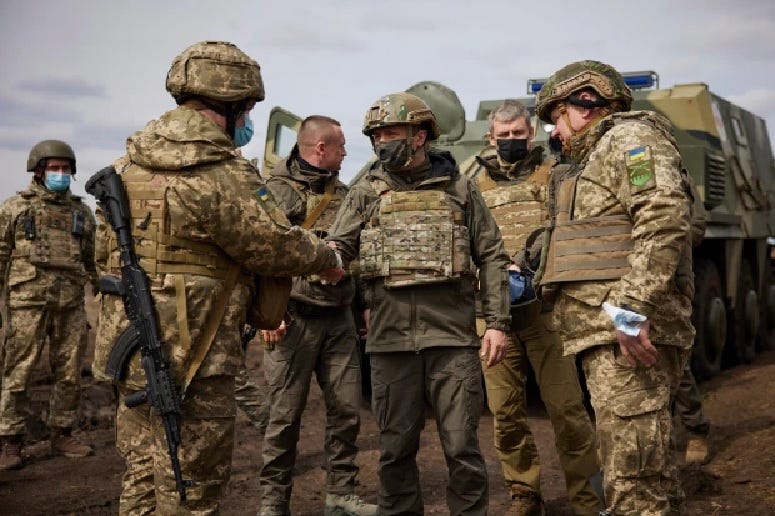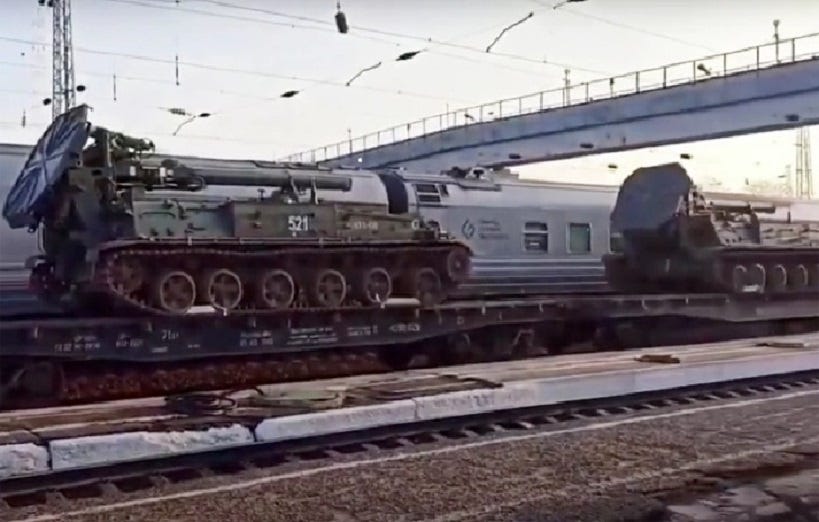Fear rises that Russia-Ukraine war could erupt in days; U.S. flies nuclear-capable bombers nearby
Russia-Ukraine crisis could "erupt into all-out war" within days after the Kremlin threatens to "end" Kiev — military tensions were pushed to breaking point.
Ukrainian President Volodymyr Zelenskiy shakes hands with a soldier near the Crimean border, where Ukraine and Russia face off with hundreds of thousands of troops. (Photo: Ivan Petrovsky/AP)
While the U.S. has been focused on critical internal matters that threaten our very existence as a nation, Russia and Ukraine are facing off over tensions stretched to the breaking point since the takeover of Crimea by the Russian military in 2015. Fears have arisen that an all-out shooting war may develop quickly which could end up drawing in most of Europe and especially NATO countries into the fight.
The terrifying news comes amid reports US nuclear bombers have been patrolling the skies after Moscow deployed tens of thousands of troops to the flashpoint border. It's been reported senior British commanders and Whitehall officials are on now “high alert” amid the simmering crisis and are said to be monitoring the escalating situation “with growing concern.”
One source who wanted to remain anonymous told ACV that aggressive Russian troop movements towards the border have caused a great deal of concern within the British Ministry of Defense.
“The situation is being monitored constantly,” our source said. “I would definitely describe this as a growing crisis.”
It was originally thought any attack from Russia would come next month, but now that Ukrainian President Volodymr Zelenskiy has vowed to take Crimea back “by force,” the full might of Vladimir Putin's military machine is expected to close in on the Ukraine within days.
A fleet of Russian warships is already heading towards the Caspian Sea armed with artillery and other weapons to back up Russia's "battle ready" land units. Kremlin spokesman Dmitry Peskov Monday said the situation in the region is becoming "explosive."
Satellite photos show stating areas like this one on the Crimean side of the border as more troops, weapons and equipment are moved into position there. (Photo: CIT)
He told reporters it was "very unstable... creating risks of full-scale combat operations."
The increased threat also comes after one of Putin’s most senior officials, Dmitry Kozak, threatened its neighbor would not survive if Russia took military action.
"I support the assessment that ... the start of military action — this would be the beginning of the end of Ukraine," said the deputy head of Russia’s presidential administration. Kozak insisted that Russia would not act unless Kiev attacked first, but added any military action by Moscow would be "not a shot in the leg, but in the face."
Tensions have soared in eastern Ukraine in recent weeks after Putin ordered tanks, helicopters and military units to the border following Zekenskiy’s announcement of potential action against the Russians illegally holding Crimea.
The Russian leader insists the military build up is defensive and that upcoming drills are part of routine "combat readiness" inspections.
Spetsnaz special forces troops and elite paratroopers are among the units now stationed at the tinderbox zone.
Tens of thousands of Ukrainian troops have been called up to protect the border and US advisers are believed to be “in country,” say sources. Chilling images have also emerged which are said to show powerful nuclear mortars being sent to the region.
At least six 2S4 Tyulpan self-propelled mortars — capable of firing warheads 12 miles — were videoed on a flatbed train in southwest Russia earlier this week.
As many as six 2S4 Tyulpan atomic motar systems — a battlefield-lvel nuclear weapon — have been seen in satellite and air reconnaisence photos being moved to or near the Crimean border with Ukraine in the last week. (Photo: Anonymous/Facebook user)
It's reported American intelligence experts now grade the worrying situation as a “potential imminent crisis.” Bruce Jones, a Janes Russia expert said Monday it is difficult to be too alarmist about this situation.
“Russia is giving a lot of evidence that it is pulling out all of the stops in order to be able to wage the widest possible range of hostilities against Ukraine,” he said. “Any such conflict would present a serious challenge to the military capability and resolve of US, EU, NATO which inevitably includes the UK.”
Amid the escalating tensions, the US is considering whether to move its own ships into the Black Sea in a show of support for Ukraine. Joe Biden would need to seek permission from Turkey for the move, because it controls the strait which provides access to the sea under the terms of a 1936 treaty.
The U.S. is also continuing to fly reconnaissance planes over the sea to monitor Russian activity and two B-1 bombers were seen flying over the Aegean Sea earlier this week, according multiple accounts. U.S. Defense officials believe Russian troops are conducting military exercises and are awaiting military orders, but said that could change at a moment's notice.
The Biden Administration has met virtually with a number of leaders across the globe in discussing the appropriate next steps should tensions escalate. When asked by reporters during the daily press briefing, White House Press Secretary Jen Psaki said Russia's advancements were "deeply concerning."
"The United States is increasingly concerned by recently escalating Russian aggressions in eastern Ukraine, including Russia's movements on Ukraine's border," she said. "Russia now has more troops on the border of Ukraine than any time since 2014. Five Ukrainian soldiers have been killed this week alone. These are all deeply concerning signs."
Russia moved BUK missiles in a region close to Ukraine after warning they "will retaliate" if the US makes any "unfriendly moves" amid the increasing tensions. The weapons system was used in the rebel-held Donetsk region in 2014 to down a Malaysia Airlines Boeing 777 killing 298 people.
New satellite images have also revealed a field camp for Russian forces in the same region as the BUKs were seen.







